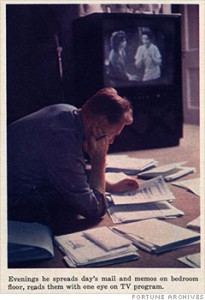How Rich People Lived in 1955

The successful American executive, for example, gets up early — about 7:00 A.M. — eats a large breakfast, and rushes to his office by train or auto. It is not unusual for him, after spending from 9:00 A.M. until 6:00 P.M. in his office, to hurry home, eat dinner, and crawl into bed with a briefcase full of homework. He is constantly pressed for time, and a great deal of the time he spends in his office is extraneous to his business. He gets himself involved in all kinds of community work, either because he wants to or because he figures he has to for the sake of public relations.
If he is a top executive he lives on an economic scale not too different from that of the man on the next-lower income rung. He surrenders around 40 per cent of his salary to the Bureau of Internal Revenue (he may cough up as much as 75 per cent) but still manages to put a little of his income in stocks, bonds, life insurance. He owns two cars, and gets along with one or two servants. What time he has left from his work — on weekends and brief vacations — he spends exercising, preferably outdoors, and usually at golf. Next to golf, fishing is the most popular executive diversion.
Here’s a fascinating Forbes article from the archives showing that in 1955, top executives in the U.S. earned $50,000 or more (about $500,000 or more in today’s figures), and apparently lived relatively modest lives (besides the one or two servants, of course — I’m talking relatively modest compared to today’s top executives). They’re living very comfortably, yes, but hey, look! They’re paying 40 percent of their salaries to the IRS, and as much as 75 percent! And they’re not living flamboyantly! The one example of flamboyant living provided is D. Harold Byrd, an oil company president, who hosts parties with 1,000 guests, flies to UT-Austin to watch football games, and gives money to students to attend college. Also, there’s a lot of yacht-talk, because there’s was only so much you could buy or do in 1955.
Support The Billfold
The Billfold continues to exist thanks to support from our readers. Help us continue to do our work by making a monthly pledge on Patreon or a one-time-only contribution through PayPal.
Comments